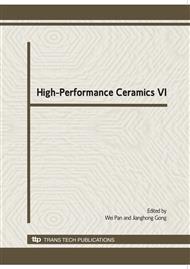p.747
p.751
p.757
p.761
p.764
p.768
p.771
p.775
p.779
Preparation of Si3N4-Al2O3 Functional Gradient Joining Material Using Transient β-Sialon Interlayer
Abstract:
The joining of high temperature structural ceramics to other materials is an important process commercially and technologically. Due to the existence of physical and economic limitations for the manufacture of large parts, joining is essential. Functional gradient materials (FGMs) are designed to exhibit a desirable gradient in a property, due ether to a gradient in composition, or microstructure, or both. In this paper, Si3N4-Al2O3 functional gradient joining material was prepared by hot press sintering of multilayered FGMs with 20 layers of thickness 400um each using β-Sialon as transient interlayer. The structure and properties of the materials were analyzed by the means of scan electron microscopy(SEM), X-ray diffraction(XRD) and micro-sclerometer. The components of the materials have gradient distribution and successional. The microhardness is gradient changing with the change of micro-structure. The interface between layers is tightly coupling and has no stress convergence. The test of thermal shock and fatigue cracks of FGM between 1300 °C and 900 °C show good properties of thermal stress relaxing and resistance for high temperature.
Info:
Periodical:
Pages:
764-767
Citation:
Online since:
March 2010
Authors:
Price:
Сopyright:
© 2010 Trans Tech Publications Ltd. All Rights Reserved
Share:
Citation:


